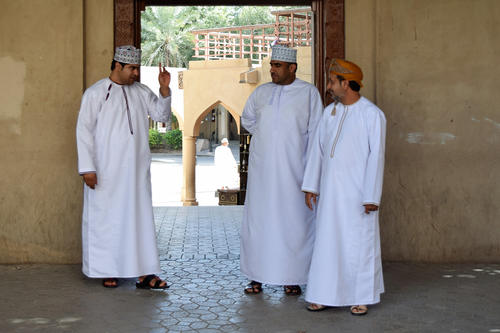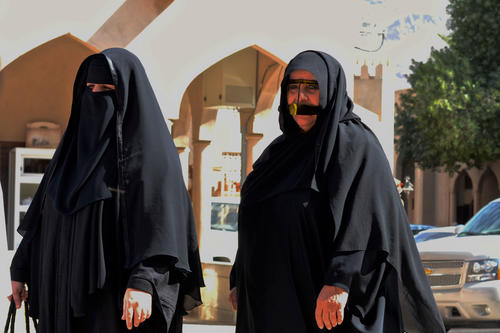Dishdasha, Abaya, and Flip Flops
Letter from Oman! Salome Bader on the traditional wear of men and women in Oman
Jan 29, 2016
Salome Bader (left) in traditional Omani dress.
Image Credit: Private
Menswear in Oman: The ankle-length tunic is called a 'dishdasha'; the headdress is known as 'kuma' or 'massar.'
Image Credit: Salome Bader
Some women wear a face mask or 'burqa.'
Image Credit: Salome Bader
An abaya, a black cloak, is worn by many women in Oman.
Image Credit: Salome Bader
A long white dress with side pockets and a tassel in the front; a round, embroidered cap (or a turban) on their head and flip flops for their feet – thus attired is how most Omani men present themselves in their everyday lives. What at first seemed a bit strange to me has become normal; to me it is now part of the Omani identity.
Of course, some three months later, I can now express my initial observations a bit differently: Omani men wear a dishdasha together with a kuma or a massar. I’ll leave flip flops as flip flops.
The dishdasha needn’t necessarily be white (though white is mandatory for those who work in the ministry); it can be worn in any other color as well. Earthy tones – but also pastels and blue tones – are popular choices next to the prevalent traditional white robe.
A kuma, hand-embroidered and thus worth about 60 Omani rial (approximately 140 euro), is worn by the majority as part of their everyday attire, while the massar is usually reserved for ceremonial occasions. The headwear is always color matched to the dishdasha.
For important events a khanjar, a curved sword, is worn decoratively on the hip. Naturally some Omanis also wear jeans and t-shirts, though usually just in their leisure time. The dishdasha is an outfit that very much dominates day to day life.
In Public Women Are Cloaked in Black
Women’s traditional dress is even more uniform; at least in the cities. They cloak themselves in black. Known as an abaya, this long black tunic is basically worn all the time in public.
But here too, black is not always black; the abaya comes in classic black, occasionally in grey and black, and sometimes it is decoratively embroidered. It is worn with a headscarf, the so-called lahaf – which comes in many colors, patterns, and variations of wear. Some women wear the headscarf loosely to reveals the hairline while others opt for a close-fitting look that conceals the hair completely.
Predominantly in the rural areas of Oman, women wear a colorful combination of wide pants that taper at the ankle along with tunic-like tops or dresses. A headscarf is worn in addition. By means of the various colors, patterns and styling it’s possible to associate the traditional dress with a particular region or a particular village.
Some women wear a mask – a burqa – or a type of veil – a niqab – in front of the face, leaving only a slit for the eyes. They wear sandals or flip flops, but pumps are very popular too. Beneath the abaya, or when they are at home, most women wear slacks, skirts, or dresses.
Clothing and Identity
I only became aware of the extent to which one’s clothes can convey identity and a sense of community since I’ve been here. At least, this is where I myself experienced this for the first time.
In the meantime, the dishdasha and the abaya have become an integral part of my image of Oman. Now, in fact, I can hardly imagine an Omani without this traditional garment. The circumstance that one hardly every catches sight of an Omani in Europe wearing a dishdasha or an abaya is owing to the fact that most Omanis adapt their attire when they travel abroad and present themselves in familiar clothing – just like they do here during their leisure time.




